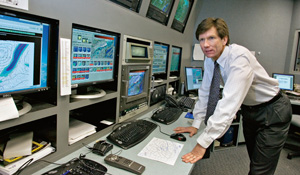

Weather Detective

WEATHER WISE: A nationally recognized expert on severe storms, John Scala '80 begins a three-year term this spring in leadership roles at the National Weather Association.
John Scala ’80 has chased severe storms and tornadoes across 13 states. He’s had a regular gig talking about the weather on national cable TV. He’s had faculty appointments at a couple of colleges anduniversities.
And he’s frequently called upon to provide expert opinion in civil and criminal cases on the forceful impact the weather can have on buildings, people, and communities.
His perspective on meteorology, in other words, is wide ranging.
“The public perception is that meteorologists forecast the weather on TV,” Scala says. “But the reality is that the field is quite a bit broader than that.”
As president-elect of the National Weather Association, Scala will help lead a like-minded group of fellow scientists, researchers, and civil servants with an interest in weather forecasting. This spring, Scala begins a three-year executive tour—one year as president-elect, one as president, and one as past president—in helping guide the 3,000-member organization.
The group, founded in 1975, focuses on operational forecasting—the science and technology used to improve how well meteorologists can understand the weather over the next few days.
Nearly all professional meteorologists in the country belong to either the National Weather Association or its larger counterpart, the American Meteorological Society.
“We’re interested in the short-term, which may go out as far as three days,” Scala says of the association’s interest in forecasting. “Our focus is a bit moretailored.”
Nationally recognized as a specialist in severe weather, Scala is an expert in forensic meteorology, the application of weather in criminal and civil cases. Scala keeps his hand in day-to-day forecasting as an on-air meteorologist for WGAL-TV in Lancaster, Pennsylvania.
As president-elect of the NWA, one of his main jobs will be helping articulate the association’s positions on a number of topics, including the big topic in meteorology right now—global climatechange.
He says the group plans to take a careful look at all the evidence before issuing policy statements.
“The argument is not whether the globe has shown a change in the long-term, mean temperature—I think everyone agrees that it has,” he says. “The debate is over the mechanisms behind the change and what can be done aboutthem.”
He also expects the group will help work to fine-tune an approach to weather prediction called “ensemble forecasting” that’s designed to recognize the probabilistic nature of weather prediction.
Although computer processing and programming has grown by leaps and bounds in recent decades, a forecast requires capturing as much environmental and meteorological data as accurately as possible to feed into forecasting models. If any of those inputs are off, even slightly, the resulting prediction will be skewed.
“Forecasting is not a linear science,” hesays.
Scala has been intrigued with science since enrolling at the University in 1976. Born in Rochester to alumni parents Robert ’58M (PhD) and Janet Eddy Scala ’55N, Scala returned to campus to study biology and geology as an undergraduate.
Originally planning to be a paleontologist, he went on to the University of Virginia, where he became interested in earth and environmental science and earned his Ph.D. in environmental sciences with an emphasis on meteorology.
After working at NASA for several years, he took a tenure-track job at SUNY Brockport, just outside Rochester, but gave it up to work for the Weather Channel. He ended up on air when the network needed an expert on severeweather.
“One thing led to another and I was on the air regularly,” he says.
He returned to academia with an appointment at Millersville University in Pennsylvania, but decided he’d rather apply his expertise as a consultant.
From his base in Pennsylvania, he has been called to study scenes of destruction across the country. Those sites include the Gulf Coast where, after Hurricane Katrina, many home and business owners are in engaged in litigation with their insurance companies over the source of damage. While it may seem almost beside the point to ask whether a home was washed away by a tidal surge or blown away by hurricane-force winds, the difference can have enormous financial consequences.
Most homeowner insurance policies, for example, don’t cover flood damage, but generally do cover wind damage.
“The big question, of course, is how do you determine what happened, if there is no house?” Scala says.
Part of his role is to collect as much accurate data about the weather—rainfall totals, wind speed, temperature, and other factors—and pinpoint that information to the time and place of thedamage.
“It’s detective work,” he says. “It’s a really intriguing application of meterology that most people have no idea about.”
—Scott Hauser
